Decepticons theme by -=Hades=-
Download: Decepticons.p3t
![]()
(1 background)
Redirect to:
This page is a redirect. The following categories are used to track and monitor this redirect:
|

The #1 spot for Playstation themes!
Decepticons theme by -=Hades=-
Download: Decepticons.p3t
![]()
(1 background)
Redirect to:
This page is a redirect. The following categories are used to track and monitor this redirect:
|
Tomb Raider theme by Tarot P. Turcato (PulseDragon)
Download: TombRaider_3.p3t

(1 background)
| Tomb Raider | |
|---|---|
 The Tomb Raider logo from 2022 onwards | |
| Genre(s) | Action-adventure |
| Developer(s) |
|
| Publisher(s) |
|
| Platform(s) |
|
| First release | Tomb Raider 25 October 1996 |
| Latest release | Tomb Raider I–III Remastered 14 February 2024 |
Tomb Raider, known as Lara Croft: Tomb Raider from 2001 to 2008, is a media franchise that originated with an action-adventure video game series created by British video game developer Core Design. The franchise is currently owned by CDE Entertainment; it was formerly owned by Eidos Interactive, then by Square Enix Europe after Square Enix's acquisition of Eidos in 2009 until Embracer Group purchased the intellectual property alongside Eidos in 2022. The franchise focuses on the fictional British archaeologist Lara Croft, who travels around the world searching for lost artefacts and infiltrating dangerous tombs and ruins. Gameplay generally focuses on exploration, solving puzzles, navigating hostile environments filled with traps, and fighting enemies. Additional media has been developed for the franchise in the form of film adaptations, comics and novels.
Development of the first Tomb Raider began in 1994; it was released two years later. Its critical and commercial success prompted Core Design to develop a new game annually for the next four years, which put a strain on staff. The sixth game, Tomb Raider: The Angel of Darkness, faced difficulties during development and was considered a failure at release. This prompted Eidos to switch development duties to Crystal Dynamics, which has been the series' primary developer since. Other developers have contributed to spin-off titles and ports of mainline entries.
Tomb Raider games have sold over 95 million copies worldwide by 2022.[1] while the entire franchise generated close to $1.2 billion in revenue by 2002.[2] The series has received generally positive reviews from critics, and Lara Croft has become one of the most recognisable video game protagonists, winning accolades and earning places on the Walk of Game and Guinness World Records.

| 1996 | Tomb Raider |
|---|---|
| 1997 | Tomb Raider II |
| 1998 | Tomb Raider III |
| 1999 | Tomb Raider: The Last Revelation |
| 2000 | Tomb Raider |
| Tomb Raider: Chronicles | |
| 2001 | Tomb Raider: Curse of the Sword |
| 2002 | Tomb Raider: The Prophecy |
| 2003 | Tomb Raider: The Angel of Darkness |
| 2004–2005 | |
| 2006 | Tomb Raider: Legend |
| 2007 | Tomb Raider: Anniversary |
| 2008 | Tomb Raider: Underworld |
| 2009 | |
| 2010 | Lara Croft and the Guardian of Light |
| 2011–2012 | |
| 2013 | Tomb Raider |
| 2014 | Lara Croft and the Temple of Osiris |
| 2015 | Lara Croft: Relic Run |
| Lara Croft Go | |
| Rise of the Tomb Raider | |
| 2016–2017 | |
| 2018 | Shadow of the Tomb Raider |
| 2019–2022 | |
| 2023 | Tomb Raider Reloaded |
| The Lara Croft Collection | |
| 2024 | Tomb Raider I–III Remastered |
The first six Tomb Raider games were developed by Core Design, a British video game development company owned by Eidos Interactive. After the sixth game in the series was released to a mixed reception in 2003, development was transferred to American studio Crystal Dynamics, who have handled the main series since.[3] Since 2001, other developers have contributed either to ports of mainline games or with the development of spin-off titles.[3][4][5][6][7][8]
The first entry in the series Tomb Raider was released in 1996 for personal computers (PC), PlayStation and Sega Saturn consoles.[9][10] The Saturn and PlayStation versions were released in Japan in 1997.[11][12] Its sequel, Tomb Raider II, launched in 1997, again for Microsoft Windows and PlayStation. A month before release, Eidos finalised a deal with Sony Computer Entertainment to keep the console version of Tomb Raider II and future games exclusive to PlayStation until the year 2000.[9][10] The PlayStation version was released in Japan in 1998.[13] Tomb Raider III launched in 1998.[10] As with Tomb Raider II, the PlayStation version released in Japan the following year.[14] The fourth consecutive title in the series, Tomb Raider: The Last Revelation, released in 1999. In 2000, with the end of the PlayStation exclusivity deal, the game also released on the Dreamcast.[9][15] In Japan, both console versions released the following year.[16][17] Tomb Raider: Chronicles released in 2000 on the same platforms as The Last Revelation, with the PlayStation version's Japanese release as before coming the following year.[9][15][18]
After a three-year gap, Tomb Raider: The Angel of Darkness was released on Microsoft Windows and PlayStation 2 (PS2) in 2003. The PlayStation 2 version was released in Japan that same year.[15][19] The next entry, Tomb Raider: Legend, was released worldwide in 2006 for the Microsoft Windows, PlayStation 2, Xbox, Xbox 360, PlayStation Portable (PSP), GameCube, Game Boy Advance (GBA) and Nintendo DS.[8][20][21] The Xbox 360, PlayStation 2 and PlayStation Portable versions were released in Japan the same year.[22] A year later, a remake of the first game titled Tomb Raider: Anniversary was released worldwide in 2007 for Microsoft Windows, PlayStation 2, PlayStation Portable, Xbox 360 and the Wii.[23] The next entry, Tomb Raider: Underworld, was released in 2008 on Microsoft Windows, PlayStation 3 (PS3), PlayStation 2, Xbox 360, Wii and DS.[24][25][26] The PlayStation 3, PlayStation 2, Xbox 360 and Wii versions were released in Japan in 2009.[27][28][29][30]
In 2011, The Tomb Raider Trilogy was released for PlayStation 3 as a compilation release that included Anniversary and Legend remastered in HD resolution, along with the PlayStation 3 version of Underworld. The disc includes avatars for PlayStation Home, a Theme Pack, new Trophies, Developer's Diary videos for the three games, and trailers for Lara Croft and the Guardian of Light as bonus content.
A reboot of the series, titled Tomb Raider, was released worldwide in 2013 for Microsoft Windows, PlayStation 3 and Xbox 360.[31][32] Its sequel, Rise of the Tomb Raider, was released in 2015 on the Xbox 360 and Xbox One.[33][34] The game was part of a timed exclusivity deal with Microsoft.[35] Versions for the PlayStation 4 and Microsoft Windows were released in 2016.[36] Another sequel, Shadow of the Tomb Raider,[37] was released worldwide on PlayStation 4, Xbox One, and Microsoft Windows in 2018.[38] An arcade game based on this incarnation was released by Bandai Namco Amusement in Europe in 2018.[39]
Core Design developed two Game Boy Colour titles in the early 2000s. The first, a side-scrolling game simply titled Tomb Raider was released in 2000.[7][40] The second, its sequel, Tomb Raider: Curse of the Sword, was released in 2001.[7][41] A Game Boy Advance title called Tomb Raider: The Prophecy, was released in 2002. Unlike the first two Game Boy titles, this was developed by Ubi Soft Milan and published by Ubi Soft, adopting an isometric perspective and moving away from the side-scrolling platform-based gameplay.[7][42]
From 2010 to 2015, a subseries simply titled Lara Croft was in development at Crystal Dynamics, with different gameplay than the main series and existing in its own continuity.[43][44] The first game, Lara Croft and the Guardian of Light, was released in 2010 as a downloadable title for PC, PS3 and Xbox 360.[43] It was followed by Lara Croft and the Temple of Osiris, released for retail and download in 2014 for PC, PS4 and Xbox One.[45] Both titles were released in a compilation entitled The Lara Croft Collection for Nintendo Switch in 2023.[46] An entry for mobile devices, an endless runner platformer titled Lara Croft: Relic Run, was released in 2015.[44] Square Enix Montreal also released a platform-puzzler for mobile devices, Lara Croft Go in 2015.[47]
In 2003, four Tomb Raider titles for mobile phones were released.[48] Developed by Emerald City Games for iOS and Android devices, Tomb Raider Reloaded is an action arcade and free-to-play game released by CDE Entertainment in 2022.[49]
After the release of The Angel of Darkness in 2003, Core Design continued working on the franchise for another three years, but both of the projects under development in that period were cancelled. A sequel titled The Lost Dominion was undergoing preliminary development that year, but the negative reception of The Angel of Darkness caused it and a wider trilogy to be scrapped.[9][50] With Eidos's approval, Core Design then began development of an updated edition of the first game for the PSP called Tomb Raider: 10th Anniversary in late 2005, with a projected release date of Christmas 2006. Development continued while other Core Design staff were working on the platformer Free Running. When Core Design was sold to Rebellion Developments in June 2006,[51] Eidos requested the project's cancellation. It was suggested by staff that Eidos did not want to let outside developers handle the franchise.[52][53] An Indiana Jones "reskin" of the game was never completed, and Free Running was ultimately the studio's final title in 2007. Core Design—by then named Rebellion Derby—shut down in 2010. A January 2006 build of 10th Anniversary was leaked online in 2020, and remains available on the Internet Archive.[54][55][56]

Lara Croft is the main protagonist and playable character of the video game series. She travels around the world in search of many forgotten artefacts and locations, frequently connected to supernatural powers.[59][60][61] While her biography has changed throughout the series, her shared traits are her origins as the only daughter and heir of the aristocratic Croft family.[59][62][63] She is portrayed as intelligent, athletic, elegant, fluent in multiple languages, and determined to fulfil her own goals at any cost. She has brown eyes and brown hair worn in a braid or ponytail. The character's classic outfit consists of a turquoise singlet, light brown shorts, calf-high boots, and tall white socks. Recurring accessories include fingerless gloves, a backpack, a utility belt with holsters on either side, and twin pistols. Later games have multiple new outfits for her.[58][64][65][66]
Lara Croft has been voiced by five actresses in the video game series: Shelley Blond, Judith Gibbins, Jonell Elliott, Keeley Hawes, and Camilla Luddington. In other media, Croft was also voiced by Minnie Driver in the animated series and portrayed by Angelina Jolie and Alicia Vikander in feature films. Multiple models and body doubles have portrayed Croft in promotional material until the reboot in 2013. Eight different real-life models have portrayed her at promotional events.[67][68]
In January 2023, The Hollywood Reporter reported that Phoebe Waller-Bridge was set to write a TV show adaptation[69] of the video game franchise for Amazon. It was also reported that this would involve a tie-in video game and film in an interconnected universe, likened to the Marvel Cinematic Universe.[70]
The circumstances of her first adventures, along with the drive behind her adventures, differ depending on the continuity. In the original continuities, she is on a plane that crashes in the Himalayas: her journey back to civilization against the odds help to begin her journey towards her adult life as an adventuress and treasure hunter.[59][62] In the original continuity, after her ordeal in the Himalayas, she left behind her privileged life and made a living writing about her exploits as an adventurer, mercenary, and cat burglar. Shortly after these books she was disowned by her family.[71][72] In The Last Revelation, Lara was caught in a collapsing pyramid at the game's end, leaving her fate unknown: this was because the staff, exhausted from four years of non-stop development, wanted to move on from the character.[67] Chronicles was told through a series of flashbacks at a wake for Lara, while The Angel of Darkness was set an unspecified time after The Last Revelation, with Lara revealed to have survived. The circumstances of her survival were originally part of the game but were cut due to time constraints and the pushing of the publisher Eidos.[67][73]
In the Legend continuity, her mother Amelia was involved in the crash, and she is partially driven by the need to discover the truth behind her mother's disappearance and vindicate her father's theories about Amelia's disappearance.[74] This obsession with the truth is present in Anniversary, and ends up bringing the world to the brink of destruction during the events of Underworld.[75][76] Her father is referred to as Lord Henshingly Croft in the original games and Lord Richard Croft in the Legend continuity.[59][62] The Lara Croft subseries take place within their own separate continuity, devoting itself to adventures similar to earlier games while the main series goes in a different stylistic direction.[44]
In the 2013 reboot continuity, Lara's mother vanished at an early age, and her father became obsessed with finding the secrets of immortality, eventually resulting in an apparent suicide. Lara distanced herself from her father's memory, believing like many others that his obsession had caused him to go mad. After studying at university, Lara gets an opportunity to work on an archaeology program, in the search for the mythic kingdom of Yamatai. The voyage to find the kingdom results in a shipwreck on an island, which is later discovered to be Yamatai, but the island is also home to savage bandits, who were victims of previous wrecks. Lara's attempts to find a way off the island lead her to discover that the island itself is stopping them from leaving, which she discovered is linked to the still-living soul of the Sun Queen Himiko. Lara tries to find a way to banish the spirit of the sun queen in order to get home. The aftermath of the events of the game causes Lara to see that her father was right, and that she had needlessly distanced herself from him. She decides to finish his work, and uncover the mysteries of the world. The game's sequels portray Lara Croft in conflict with an ancient organization Trinity, in their quest to obtain supernatural items for their world domination.

The gameplay of Tomb Raider is primarily based around an action-adventure framework, with Lara navigating environments and solving mechanical and environmental puzzles, in addition to fighting enemies and avoiding traps. These puzzles, primarily set within ancient tombs and temples, can extend across multiple rooms and areas within a level. Lara can swim through water, a rarity in games at the time that has continued through the series.[20][67][77][78] According to original software engineer and later studio manager Gavin Rummery, the original set-up of interlinking rooms was inspired by Egyptian multi-roomed tombs, particularly the tomb of Tutankhamun.[67] The feel of the gameplay was intended to evoke that of the 1989 video game Prince of Persia.[79] In the original games, Lara utilised a "bulldozer" steering set-up, with two buttons pushing her forward and back and two buttons steering her left and right, and in combat Lara automatically locked onto enemies when they came within range. The camera automatically adjusts depending on Lara's action, but defaults to a third-person perspective in most instances. This basic formula remained unchanged through the first series of games. Angel of Darkness added stealth elements.[77][78][80][81]
For Legend, the control scheme and character movement was redesigned to provide a smooth and fluid experience. One of the key elements present was how buttons for different actions cleanly transitioned into different actions, along with these moves being incorporated into combat to create effects such as stunning or knocking down enemies. Quick-time events were added into certain segments within each level, and many of the puzzles were based around sophisticated in-game physics.[20][67][82][83] Anniversary, while going through the same locales of the original game, was rebuilt using the gameplay and environmental puzzles of Legend.[84] For Underworld, the gameplay was redesigned around a phrase the staff had put to themselves: "What Could Lara Do?". Using this set-up, they created a greater variety of moves and greater interaction with the environment, along with expanding and improving combat.[85]
The gameplay underwent another major change for the 2013 reboot. Gameplay altered from progression through linear levels to navigating an open world, with hunting for supplies and upgrading equipment and weapons becoming a key part of gameplay, yet tombs were mostly optional, and platforming was less present in comparison to combat. The combat was redesigned to be similar to the Uncharted series: the previous reticle-based lock-on mechanics were replaced by a free-roaming aim.[86] Rise of the Tomb Raider built on the 2013 reboot's foundation, adding dynamic weather systems, reintroducing swimming, and increasing the prevalence of non-optional tombs with more platforming elements.[87]
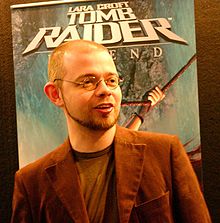
The concept for Tomb Raider originated in 1994 at Core Design, a British game development studio.[88] One of the people involved in its creation was Toby Gard, who was mostly responsible for creating the character of Lara Croft. Gard originally envisioned the character as a man: company co-founder Jeremy Heath-Smith was worried the character would be seen as derivative of Indiana Jones, so Gard changed the character's gender. Her design underwent mult
Star Wars for Lawk theme by sjarper
Download: StarWarsForLawk.p3t
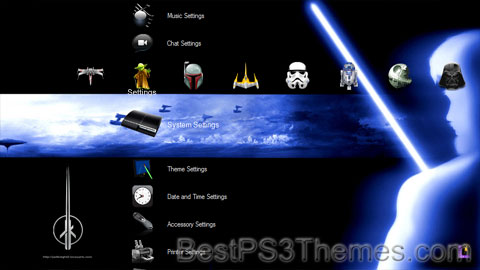
(5 backgrounds)
P3T Unpacker v0.12
Copyright (c) 2007. Anoop Menon
This program unpacks Playstation 3 Theme files (.p3t) so that you can touch-up an existing theme to your likings or use a certain wallpaper from it (as many themes have multiple). But remember, if you use content from another theme and release it, be sure to give credit!
Download for Windows: p3textractor.zip
Instructions:
Download p3textractor.zip from above. Extract the files to a folder with a program such as WinZip or WinRAR. Now there are multiple ways to extract the theme.
The first way is to simply open the p3t file with p3textractor.exe. If you don’t know how to do this, right click the p3t file and select Open With. Alternatively, open the p3t file and it will ask you to select a program to open with. Click Browse and find p3textractor.exe from where you previously extracted it to. It will open CMD and extract the theme to extracted.[filename]. After that, all you need to do for any future p3t files is open them and it will extract.
The second way is very simple. Just drag the p3t file to p3textractor.exe. It will open CMD and extract the theme to extracted.[filename].
For the third way, first put the p3t file you want to extract into the same folder as p3textractor.exe. Open CMD and browse to the folder with p3extractor.exe. Enter the following:
p3textractor filename.p3t [destination path]Replace filename with the name of the p3t file, and replace [destination path] with the name of the folder you want the files to be extracted to. A destination path is not required. By default it will extract to extracted.filename.
Superman versionD theme by Deemy
Download: Superman_versionD.p3t
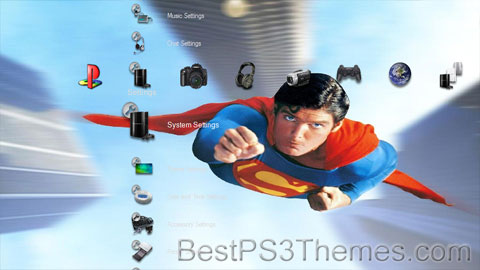
(7 backgrounds)
P3T Unpacker v0.12
Copyright (c) 2007. Anoop Menon
This program unpacks Playstation 3 Theme files (.p3t) so that you can touch-up an existing theme to your likings or use a certain wallpaper from it (as many themes have multiple). But remember, if you use content from another theme and release it, be sure to give credit!
Download for Windows: p3textractor.zip
Instructions:
Download p3textractor.zip from above. Extract the files to a folder with a program such as WinZip or WinRAR. Now there are multiple ways to extract the theme.
The first way is to simply open the p3t file with p3textractor.exe. If you don’t know how to do this, right click the p3t file and select Open With. Alternatively, open the p3t file and it will ask you to select a program to open with. Click Browse and find p3textractor.exe from where you previously extracted it to. It will open CMD and extract the theme to extracted.[filename]. After that, all you need to do for any future p3t files is open them and it will extract.
The second way is very simple. Just drag the p3t file to p3textractor.exe. It will open CMD and extract the theme to extracted.[filename].
For the third way, first put the p3t file you want to extract into the same folder as p3textractor.exe. Open CMD and browse to the folder with p3extractor.exe. Enter the following:
p3textractor filename.p3t [destination path]Replace filename with the name of the p3t file, and replace [destination path] with the name of the folder you want the files to be extracted to. A destination path is not required. By default it will extract to extracted.filename.
Terminator theme by Nigel Mansell
Download: Terminator.p3t
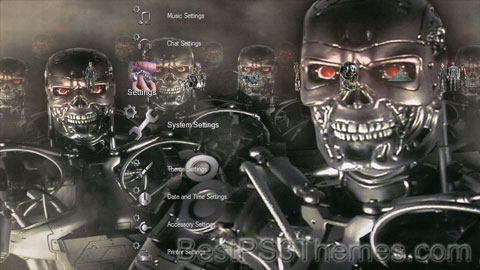
(6 backgrounds)
Terminator may refer to:
Tails theme by Beast
Download: Tails.p3t
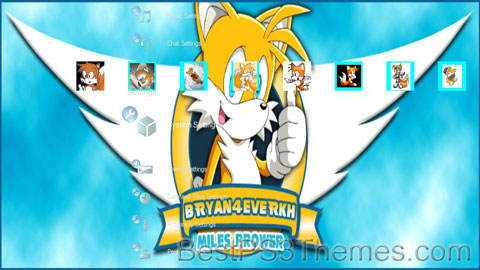
(1 background)
Redirect to:
This page is a redirect. The following categories are used to track and monitor this redirect:
|
Watchmen theme by Proinsias
Download: Watchmen.p3t
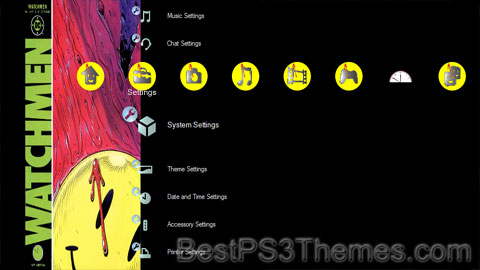
(13 backgrounds)
| Watchmen | |
|---|---|
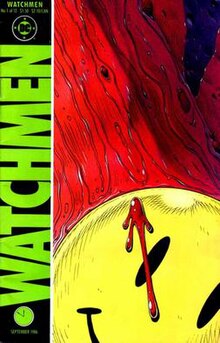 Cover of Watchmen #1 (September 1986) Art by Dave Gibbons | |
| Date | 1986–1987 |
| Publisher | DC Comics |
| Creative team | |
| Writer | Alan Moore |
| Artist | Dave Gibbons |
| Colorist | John Higgins |
| Editors | |
| Original publication | |
| Published in | Watchmen |
| Issues | 12 |
| Date of publication | September 1986 – October 1987 |
Watchmen is a comic book limited series by the British creative team of writer Alan Moore, artist Dave Gibbons and colorist John Higgins. It was published monthly by DC Comics in 1986 and 1987 before being collected in a single-volume edition in 1987. Watchmen originated from a story proposal Moore submitted to DC featuring superhero characters that the company had acquired from Charlton Comics. As Moore's proposed story would have left many of the characters unusable for future stories, managing editor Dick Giordano convinced Moore to create original characters instead.
Moore used the story as a means of reflecting contemporary anxieties, of deconstructing and satirizing the superhero concept and of making political commentary. Watchmen depicts an alternate history in which superheroes emerged in the 1940s and 1960s and their presence changed history so that the United States won the Vietnam War and the Watergate scandal was never exposed. In 1985 the country is edging toward World War III with the Soviet Union, freelance costumed vigilantes have been outlawed and most former superheroes are in retirement or working for the government. The story focuses on the protagonists' personal development and moral struggles as an investigation into the murder of a government-sponsored superhero pulls them out of retirement.
Gibbons uses a nine-panel grid layout throughout the series and adds recurring symbols such as a blood-stained smiley face. All but the last issue feature supplemental fictional documents that add to the series' backstory and the narrative is intertwined with that of another story, an in-story pirate comic titled Tales of the Black Freighter, which one of the characters reads. Structured at times as a nonlinear narrative, the story skips through space, time and plot. In the same manner, entire scenes and dialogues have parallels with others through synchronicity, coincidence, and repeated imagery.
A commercial success, Watchmen has received critical acclaim both in the comics and mainstream press. Watchmen was recognized in Time's List of the 100 Best Novels as one of the best English language novels published since 1923. In a retrospective review, the BBC's Nicholas Barber described it as "the moment comic books grew up".[1] Moore opposed this idea, stating, "I tend to think that, no, comics hadn't grown up. There were a few titles that were more adult than people were used to. But the majority of comics titles were pretty much the same as they'd ever been. It wasn't comics growing up. I think it was more comics meeting the emotional age of the audience coming the other way."[2]
After a number of attempts to adapt the series into a feature film, director Zack Snyder's Watchmen was released in 2009. A video game series, Watchmen: The End Is Nigh, was released to coincide with the film's release.
DC Comics published Before Watchmen, a series of nine prequel miniseries, in 2012, and Doomsday Clock, a 12-issue limited series and sequel to the original Watchmen series, from 2017 to 2019 – both without Moore's or Gibbons' involvement. The second series integrated the Watchmen characters within the DC Universe. A standalone sequel, Rorschach by Tom King, began publication in October 2020. A television continuation to the original comic, set 34 years after the comic's timeline, was broadcast on HBO from October to December 2019 with Gibbons' involvement. Moore has expressed his displeasure with adaptations and sequels of Watchmen and asked it not be used for future works.[3]
Watchmen, created by writer Alan Moore and artist Dave Gibbons, first appeared in the 1985 issue of DC Spotlight, the 50th anniversary special. It was eventually published as a 12-issue maxiseries from DC Comics, cover-dated September 1986 to October 1987.[4]
| No. | Title | Publication date | On-sale date | Ref. |
|---|---|---|---|---|
1
|
"At Midnight, All the Agents..." | September 1986 | May 13, 1986 | |
2
|
"Absent Friends" | October 1986 | June 10, 1986 | |
3
|
"The Judge of All the Earth" | November 1986 | July 8, 1986 | |
4
|
"Watchmaker" | December 1986 | August 12, 1986 | |
5
|
"Fearful Symmetry" | January 1987 | September 9, 1986 | |
6
|
"The Abyss Gazes Also" | February 1987 | October 14, 1986 | |
7
|
"A Brother to Dragons" | March 1987 | November 11, 1986 | |
8
|
"Old Ghosts" | April 1987 | December 9, 1986 | |
9
|
"The Darkness of Mere Being" | May 1987 | January 13, 1987 | |
10
|
"Two Riders Were Approaching..." | July 1987 | March 17, 1987 | |
11
|
"Look on My Works, Ye Mighty..." | August 1987 | May 19, 1987 | |
12
|
"A Stronger Loving World" | October 1987 | July 28, 1987 |
It was subsequently collected in 1987 as a DC Comics trade paperback that has had at least 24 printings as of March 2017;[17] another trade paperback was published by Warner Books, a DC sister company, in 1987.[18] In February 1988, DC published a limited-edition, slipcased hardcover volume, produced by Graphitti Design, that contained 48 pages of bonus material, including the original proposal and concept art.[19][20] In 2005, DC released Absolute Watchmen, an oversized slipcased hardcover edition of the series in DC's Absolute Edition format. Assembled under the supervision of Dave Gibbons, Absolute Watchmen included the Graphitti materials, as well as restored and recolored art by John Higgins.[21] That December DC published a new printing of Watchmen issue #1 at the original 1986 cover price of $1.50 as part of its "Millennium Edition" line.[22]
In 2012, DC published Before Watchmen, a series of nine prequel miniseries, with various creative teams producing the characters' early adventures set before the events of the original series.[23]
In the 2016 one-shot DC Universe: Rebirth Special, numerous symbols and visual references to Watchmen, such as the blood-splattered smiley face, and the dialogue between Doctor Manhattan and Ozymandias in the last issue of Watchmen, are shown.[24] Further Watchmen imagery was added in the DC Universe: Rebirth Special #1 second printing, which featured an update to Gary Frank's cover, better revealing the outstretched hand of Doctor Manhattan in the top right corner.[25][26] Doctor Manhattan later appeared in the 2017 four-part DC miniseries The Button serving as a direct sequel to both DC Universe Rebirth and the 2011 storyline "Flashpoint". Manhattan reappears in the 2017–19 twelve-part sequel series Doomsday Clock.[27]
"I suppose I was just thinking, 'That'd be a good way to start a comic book: have a famous super-hero found dead.' As the mystery unraveled, we would be led deeper and deeper into the real heart of this super-hero's world, and show a reality that was very different to the general public image of the super-hero."
—Alan Moore on the basis for Watchmen[28]
In 1983, DC Comics acquired a line of characters from Charlton Comics.[29] During that period, writer Alan Moore contemplated writing a story that featured an unused line of superheroes that he could revamp, as he had done in his Miracleman series in the early 1980s. Moore reasoned that MLJ Comics' Mighty Crusaders might be available for such a project, so he devised a murder mystery plot which would begin with the discovery of the body of the Shield in a harbor. The writer felt it did not matter which set of characters he ultimately used, as long as readers recognized them "so it would have the shock and surprise value when you saw what the reality of these characters was".[28] Moore used this premise and crafted a proposal featuring the Charlton characters titled Who Killed the Peacemaker,[30] and submitted the unsolicited proposal to DC managing editor Dick Giordano.[31] Giordano was receptive to the proposal, but opposed the idea of using the Charlton characters for the story. After the acquisition of Charlton's Action Hero line, DC intended to use their upcoming Crisis on Infinite Earths event to fold them into their mainstream superhero universe. Moore said, "DC realized their expensive characters would end up either dead or dysfunctional." Instead, Giordano persuaded Moore to continue his project but with new characters that simply resembled the Charlton heroes.[32][33][34] Moore had initially believed that original characters would not provide emotional resonance for readers but later changed his mind. He said, "Eventually, I realized that if I wrote the substitute characters well enough, so that they seemed familiar in certain ways, certain aspects of them brought back a kind of generic super-hero resonance or familiarity to the reader, then it might work."[28]
Artist Dave Gibbons, who had collaborated with Moore on previous projects, recalled that he "must have heard on the grapevine that he was doing a treatment for a new miniseries. I rang Alan up, saying I'd like to be involved with what he was doing", and Moore sent him the story outline.[35] Gibbons told Giordano he wanted to draw the series Moore proposed and Moore approved.[36] Gibbons brought colorist John Higgins onto the project because he liked his "unusual" style; Higgins lived near the artist, which allowed the two to "discuss [the art] and have some kind of human contact rather than just sending it across the ocean".[30] Len Wein joined the project as its editor, while Giordano stayed on to oversee it. Both Wein and Giordano stood back and "got out of their way", as Giordano remarked later. "Who copy-edits Alan Moore, for God's sake?"[31]
After receiving the go-ahead to work on the project, Moore and Gibbons spent a day at the latter's house creating characters, crafting details for the story's milieu and discussing influences. The pair were particularly influenced by a Mad parody of Superman named "Superduperman"; Moore said: "We wanted to take Superduperman 180 degrees—dramatic, instead of comedic".[34] Moore and Gibbons conceived of a story that would take "familiar old-fashioned superheroes into a completely new realm";[37] Moore said his intention was to create "a superhero Moby Dick; something that had that sort of weight, that sort of density".[38] Moore came up with the character names and descriptions but left the specifics of how they looked to Gibbons. Gibbons did not sit down and design the characters deliberately, but rather "did it at odd times [...] spend[ing] maybe two or three weeks just doing sketches."[30] Gibbons designed his characters to make them easy to draw; Rorschach was his favorite to draw because "you just have to draw a hat. If you can draw a hat, then you've drawn Rorschach, you just draw kind of a shape for his face and put some black blobs on it and you're done."[39]
Moore began writing the series very early on, hoping to avoid publication delays such as those faced by the DC limited series Camelot 3000.[40] When writing the script for the first issue Moore said he realized "I only had enough plot for six issues. We were contracted for 12!" His solution was to alternate issues that dealt with the overall plot of the series with origin issues for the characters.[41] Moore wrote very detailed scripts for Gibbons to work from. Gibbons recalled that "[t]he script for the first issue of Watchmen was, I think, 101 pages of typescript—single-spaced—with no gaps between the individual panel descriptions or, indeed, even between the pages." Upon receiving the scripts, the artist had to number each page "in case I drop them on the floor, because it would take me two days to put them back in the right order", and used a highlighter pen to single out lettering and shot descriptions; he remarked, "It takes quite a bit of organizing before you can actually put pen to paper."[42] Despite Moore's detailed scripts, his panel descriptions would often end with the note "If that doesn't work for you, do what works best"; Gibbons nevertheless worked to Moore's instructions.[43] In fact, Gibbons only suggested one single change to the script - a compression of Ozymandias' narration while he was preventing a sneak attack by Rorschach - as he felt that the dialogue was too long to fit with the length of the action; Moore agreed and re-wrote the scene.[44] Gibbons had a great deal of autonomy in developing the visual look of Watchmen and frequently inserted background details that Moore admitted he did not notice until later.[38] Moore occasionally contacted fellow comics writer Neil Gaiman for answers to research questions and for quotes to include in issues.[41]
Despite his intentions, Moore admitted in November 1986 that there were likely to be delays, stating that he was, with issue five on the stands, still writing issue nine.[42] Gibbons mentioned that a major factor in the delays was the "piecemeal way" in which he received Moore's scripts. Gibbons said the team's pace slowed around the fourth issue; from that point onward the two undertook their work "just several pages at a time. I'll get three pages of script from Alan and draw it and then toward the end, call him up and say, 'Feed me!' And he'll send another two or three pages or maybe one page or sometimes six pages."[45] As the creators began to hit deadlines, Moore would hire a taxi driver to drive 50 miles and deliver scripts to Gibbons. On later issues the artist even had his wife and son draw panel grids on pages to help save time.[41]
Near the end of the project, Moore realized that the story bore some similarity to "The Architects of Fear", an episode of The Outer Limits television series.[41] The writer and Wein (an editor) argued over changing the ending and when Moore refused to give in, Wein quit the book. Wein explained, "I kept telling him, 'Be more original, Alan, you've got the capability, do something different, not something that's already been done!' And he didn't seem to care enough to do that."[46] Moore acknowledged the Outer Limits episode by referencing it in the series' last issue.[43]
Watchmen is set in an alternate reality that closely mirrors the contemporary world of the 1980s. The primary difference is the presence of superheroes. The point of divergence occurs in the year 1938. Their existence in this version of the United States is shown to have dramatically affected and altered the outcomes of real-world events such as the Vietnam War and the presidency of Richard Nixon.[47] In keeping with the realism of the series, although the costumed crimefighters of Watchmen are commonly called "superheroes", only one, named Doctor Manhattan, possesses any superhuman abilities.[48] The war in Vietnam ends with an American victory in 1971 and Nixon is still president as of October 1985 upon the repeal of term limits and the Watergate scandal not coming to pass. The Soviet invasion of Afghanistan occurs approximately six years later than in real life.
When the story begins, the existence of Doctor Manhattan has given the U.S. a strategic advantage over the Soviet Union, which has dramatically increased Cold War tensions. Eventually, by 1977, superheroes grow unpopular among the police and the public, leading them to be outlawed with the passage of the Keene Act. While many of the heroes retired, Doctor Manhattan and another superhero, known as The Comedian, operate as government-sanctioned agents. Another named Rorschach continues to operate outside the law.[49]
In October 1985, New York City detectives investigate the murder of Edward Blake. With the police having no leads, costumed vigilante Rorschach decides to probe further. Rorschach deduces Blake to have been the true identity of "The Comedian", a costumed hero employed by the U.S. government, after finding his costume and signature smiley-face pin badge. Believing that Blake's murder could be part of a larger plot against costumed adventurers, Rorschach seeks out and warns four of his retired comrades: shy inventor Daniel Dreiberg, formerly the second Nite Owl; the superpowered and emotionally detached Jon Osterman, codenamed "Doctor Manhattan"; Doctor Manhattan's lover Laurie Juspeczyk, the second Silk Spectre; and Adrian Veidt, once the hero "Ozymandias", and now a successful businessman.
Dreiberg, Veidt, and Manhattan attend Blake's funeral, where Dreiberg tosses Blake's pin badge in his coffin before he is buried. Manhattan is later accused on national television of being the cause of cancer in friends and former colleagues. When the government takes the accusations seriously, Manhattan exiles himself to Mars. As the United States depends on Manhattan as a strategic military asset, his departure throws humanity into political turmoil, with the Soviets invading Afghanistan to capitalize on the United States' perceived weakness. Rorschach's concerns appear validated when Veidt narrowly survives an assassination attempt. Rorschach himself is framed for murdering a former supervillain named Moloch. While attempting to flee the scene of Moloch's murder, Rorschach is captured by police and unmasked as Walter Kovacs.
Neglected in her relationship with the once-human Manhattan, whose godlike powers have left him emotionally detached from ordinary people, and no longer kept on retainer by the government, Juspeczyk stays with Dreiberg. They begin a romance, don their costumes, and resume vigilante work as they grow closer together. With Dreiberg starting to believe some aspects of Rorschach's conspiracy theory, the pair take it upon themselves to break him out of prison. After looking back on his own personal history, Manhattan places the fate of his involvement with human affairs in Juspeczyk's hands. He teleports her to Mars to make the case for emotional investment. During the course of the argument, Juspeczyk is forced to come to terms with the fact that Blake, who once attempted to rape her mother (the original Silk Spectre), was actually her biological father, having fathered her in a second, consensual relationship. This discovery, reflecting the complexity of human emotions and relationships, reignites Manhattan's interest in humanity.
On Earth, Dreiberg and Rorschach find evidence that Veidt may be behind the conspiracy. Rorschach writes his suspicions about Veidt in his journal, which includes the full details of his investigation, and mails it to New Frontiersman, a local right-wing newspaper. When Rorschach and Dreiberg travel to Antarctica to confront Veidt at his private retreat, Veidt explains that he plans to save humanity from an impending nuclear war by staging a fake alien invasion and killing half the population of New York, forcing the United States and the Soviet Union to unite against a common enemy. He reveals that he murdered Blake after he discovered his plan, arranged for Doctor Manhattan's past associates to contract cancer to force him to leave Earth, staged the attempt on his own life to place himself above suspicion, and framed Rorschach for Moloch's murder to prevent him from discovering the truth. Horrified by Veidt's callous logic, Dreiberg and Rorschach vow to stop him, but Veidt reveals that he already enacted his plan before they arrived.
When Manhattan and Juspeczyk arrive back on Earth, they are confronted by mass destruction and death in New York, with a gigantic squid-like creature, created by Veidt's laboratories, dead in the middle of the city. Manhattan notices his prescient abilities are limited by tachyons emanating from the Antarctic and the pair teleport there. They discover Veidt's involvement and confront him. Veidt shows everyone news broadcasts confirming that the emergence of a new threat has indeed prompted peaceful co-operation between the superpowers; this leads almost all present to agree that concealing the truth is in the best interests of world peace. Rorschach refuses to compromise and leaves, intent on revealing the truth. As he is making his way back, he is confronted by Manhattan who argues that at this point, the truth can only hurt. Rorschach declares that Manhattan will have to kill him to stop him from exposing Veidt, which Manhattan duly does. Manhattan then wanders through the base and finds Veidt, who asks him if he did the right thing in the end. Manhattan cryptically responds that "nothing ever ends" before leaving Earth. Dreiberg and Juspeczyk go into hiding under new identities and continue their romance.
Back in New York, the editor at New Frontiersman asks his assistant to find some filler material from the "crank file", a collection of rejected submissions to the paper, many of which have not yet been reviewed. The series ends with the young man reaching toward the pile of discarded submissions, near the top of which is Rorschach's journal.
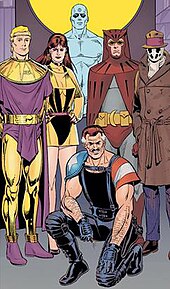
With Watchmen, Alan Moore's intention was to create four or five "radically opposing ways" to perceive the world and to give readers of the story the privilege of determining which one was most morally comprehensible. Moore did not believe in the notion of "[cramming] regurgitated morals" down the readers' throats and instead sought to show heroes in an ambivalent light. Moore said, "What we wanted to do was show all of these people, warts and all. Show that even the worst of them had something going for them, and even the best of them had their flaws."[38]
Road To Perdition theme by DominatorCGI
Download: RoadToPerdition.p3t
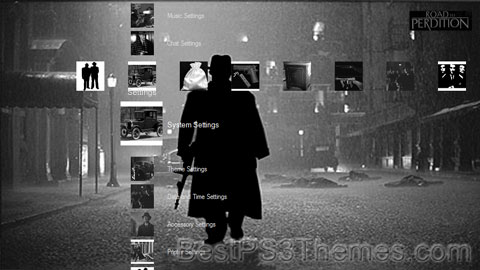
(1 background)
Redirect to:
Torchwood theme by Steve G
Download: Torchwood.p3t

(1 background)
| Torchwood | |
|---|---|
| Genre | |
| Created by | Russell T Davies |
| Showrunners |
|
| Starring | |
| Theme music composer | Murray Gold |
| Composers | |
| Country of origin |
|
| Original language | English |
| No. of series | 4 |
| No. of episodes | 41 (list of episodes) |
| Production | |
| Executive producers | |
| Running time | 45–60 minutes |
| Production companies | |
| Original release | |
| Network | BBC Three |
| Release | 22 October 2006 – 1 January 2007 |
| Network | BBC Two |
| Release | 16 January – 4 April 2008 |
| Network | BBC One |
| Release | 6 July 2009 – 15 September 2011 |
| Network | Starz |
| Release | 8 July – 9 September 2011 |
| Related | |
| Torchwood Declassified Doctor Who The Sarah Jane Adventures Class | |
Torchwood is a British science fiction television programme created by Russell T Davies. A spin-off of the 2005 revival of Doctor Who, it aired from 2006 to 2011. The show shifted its broadcast channel each series to reflect its growing audience, moving from BBC Three to BBC Two to BBC One, and acquiring American financing in its fourth series when it became a co-production of BBC One and Starz. Torchwood is aimed at adults and older teenagers, in contrast to Doctor Who's target audience of both adults and children. As well as science fiction, the show explores a number of themes, including existentialism, LGBTQ+ sexuality, and human corruptibility.
Torchwood follows the exploits of a small team of alien-hunters who make up the Cardiff-based, fictional Torchwood Institute, which deals mainly with incidents involving extraterrestrials. Its central character is Captain Jack Harkness (John Barrowman), an immortal con-man from the distant future; Jack originally appeared in the 2005 series of Doctor Who. The initial main cast of the series consisted of Gareth David-Lloyd, Burn Gorman, Naoko Mori, and Eve Myles. Their characters are specialists for the Torchwood team, often tracking down aliens and defending the planet from alien and human threats. In its first two series, the show uses a time rift in Cardiff as its primary plot generator, accounting for the unusual preponderance of alien beings in Cardiff. In the third and fourth series, Torchwood operate as fugitives. Gorman and Mori's characters were written out of the story at the end of the second series. Recurring actor Kai Owen was promoted to the main cast in series three, in which David-Lloyd was written out. Subsequently, American actors Mekhi Phifer, Alexa Havins and Bill Pullman joined the cast of the show for its fourth series.
The first series premiered on BBC Three and on BBC HD in 2006 to mixed reviews, but viewing figures broke records for the digital channel. It returned in 2008 where it aired first on BBC Two, receiving a higher budget; its uneven tone, a criticism of the first series, was largely smoothed out, and the show attracted higher ratings and better reviews. The third series' episodes worked with a higher budget, and it was transferred to the network's flagship channel, BBC One, as a five-episode serial titled Torchwood: Children of Earth. Although Children of Earth was broadcast over a period of five consecutive summer weeknights, the show received high ratings in the United Kingdom and overseas. A fourth series, co-produced by BBC Wales, BBC Worldwide and US premium entertainment network Starz aired in 2011 under the title Torchwood: Miracle Day. Set both in Wales and the United States, Miracle Day fared less well with critics than Children of Earth, although it was applauded by some for its ambition. The series entered an indefinite hiatus after Miracle Day due to Davies' personal circumstances.
All four televised series have been broadcast in Asia, Australia, New Zealand, Europe and North America. Owing to the early popularity of Torchwood, various tie-in media were produced,[7] including audio dramas, novels and comic strips. From its inception, the BBC invested in a heavy online presence for the series, with an alternate reality game running alongside the show's first two series, and an animated Web series running alongside its fourth. The BBC continued to approve and commission licensed spin-offs after the show's conclusion, including an audio series continuation from Big Finish Productions (2015–present).
On 21 February 2020, all 41 televised episodes returned to the BBC's online streaming service, BBC iPlayer. In the United States, the entire series was made available on HBO's new streaming service, HBO Max, upon its launch in May 2020.
Before the revival of Doctor Who, Russell T Davies began to develop an idea for a science-fiction/crime drama in the style of American dramas, in particular those created by Joss Whedon like Buffy the Vampire Slayer and Angel.[8][9] This idea, originally titled Excalibur, was abandoned until 2005, when BBC Three Controller Stuart Murphy invited Davies to develop an after-watershed science fiction series for the channel.[9] During the production of the 2005 series of Doctor Who, the word "Torchwood", an anagram of "Doctor Who", had been used as a title ruse for the series while filming its first few episodes to ensure they were not intercepted.[10] Davies connected the word "Torchwood" to his earlier Excalibur idea and decided to make the series a Doctor Who spin-off.[9] Subsequently, the word "Torchwood" was seeded in Doctor Who episodes and other media that aired in 2005 and 2006.
Because Torchwood is shown after the watershed – that is, after 9 pm – it has more mature content than Doctor Who. Davies told SFX:
We can be a bit more visceral, more violent, and more sexual, if we want to. Though bear in mind that it's very teenage to indulge yourself in blood and gore, and Torchwood is going to be smarter than that. But it's the essential difference between BBC One at 7 pm, and BBC Three at, say, 9 pm. That says it all – instinctively, every viewer can see the huge difference there.[11][12]
According to Barrowman: "I don't do any nude scenes in series one; they're saving that for the next series! I don't have a problem with getting my kit off, as long as they pay me the right money."[13] Davies also joked to a BBC Radio Wales interviewer that he was "not allowed" to refer to the programme as "Doctor Who for grown-ups".[14] The first series includes content rarely seen or heard in the Doctor Who franchise, including sex scenes and use of profanity in several episodes.[15][16]
BBC Three described Torchwood as the centrepiece of its autumn 2006 schedule,[17] and the successful first series led to a second series on BBC Two and a third on BBC One in 2009.[18]
Although Torchwood was originally intended to be sci-fi aimed at adults, the character Captain Jack Harkness, who had previously been introduced in Doctor Who, proved popular with young audiences. Davies decided to create alternative edits of the second series to be "child-friendly", removing overt sexuality and swearing. These edits to the shows enabled it to be broadcast at 7 pm (pre-watershed).[19][20]
The first three series of Torchwood were produced in-house by BBC Wales. The Head of Drama at the time of the first series, Julie Gardner, served as executive producer alongside Davies. The first two episodes of series 1 of Torchwood premiered on 22 October 2006 on BBC Three and BBC HD. Series 2 premiered on BBC Two and BBC HD on 16 January 2008.[21] The third series, Torchwood: Children of Earth, began shooting on 18 August 2008 and comprised a five-episode mini-series that aired over five consecutive days at 9 pm on BBC One from 6 July 2009,[22][23][24][25] and 9 pm on BBC America HD and BBC America from 20 July 2009.[26] Davies and Gardner stayed on as executive producers and Peter Bennett produced the series.[27][28]
Davies expressed concern that the third series was aired in a summer evening graveyard slot.[29] Lead actor John Barrowman felt that the show had been mistreated by BBC executives, despite what he felt was the programme's proven popularity and success.[18]
In August 2009, Davies stated that the fourth series was "ready to go",[30] and that he had the next series planned out, stating, "I know exactly how to pick it up. I've got a shape in mind, and I've got stories. I know where you'd find Gwen and Rhys, and their baby, and Jack, and I know how you'd go forward with a new form of Torchwood." At the time, he stated he would prefer for series four to be another mini-series, though he had no qualms about doing another thirteen-episode run.[31] A November 2009 article posted on Eve Myles's website stated that shooting for the fourth series was to begin in January 2011.[32]
Subsequently, Davies looked to US networks to finance future series of the programme. He was turned down by one of the United States' major television networks, Fox;[33] some had speculated the Fox project could have been a spin-off or a reboot.[34] Later, Davies succeeded in striking a deal with US premium cable network Starz.[35] The production of the fourth series was not officially announced until June 2010:[36][37] a ten-episode mini-series co-produced between BBC Wales, Starz and BBC Worldwide,[36] airing summer 2011.[38]
As with the third, the fourth series was given its own title: Torchwood: Miracle Day.[39] Shortly after the broadcast of Miracle Day in March 2012, the chief executive officer of Starz, Chris Albrecht, announced that he was remaining in touch with the BBC regarding a further series of Torchwood, though it would depend on Davies being free from his other commitments.[40] However, by 2012 the show had entered an indefinite hiatus due to Davies' return to the UK after his partner became ill.[41][42][43]
In the first series, the main writer alongside Russell T Davies was Chris Chibnall, creator of the BBC light drama show Born and Bred and future Doctor Who showrunner. Other writers include P.J. Hammond, Toby Whithouse, Doctor Who script editor Helen Raynor, Catherine Tregenna and Doctor Who cast member Noel Clarke. Of the first two series, Russell T Davies wrote only the première episode.[12][44] Helen Raynor and Brian Minchin were the programme's script editors.[45]
Series one of Torchwood was filmed from May 2006 until November 2006. For the second series,[21] lead writer Chris Chibnall wrote the opening episode and the three final episodes.[46][citation needed] Both Catherine Tregenna and Helen Raynor wrote two episodes for the second series.[47] The other episodes were written by James Moran, Matt Jones, J. C. Wilsher, Joseph Lidster, P.J. Hammond and Phil Ford. Russell T Davies was initially announced as writing two episodes, but due to commitments to Doctor Who, he no longer anticipated writing any Torchwood episodes.[48] For series three, Davies returned and wrote the first and last episodes, co-wrote episode three with James Moran and plotted the overall story arc himself.[28] John Fay wrote episodes two and four.[49]
For the fourth series, Miracle Day, Davies secured several popular US television writers, including Buffy the Vampire Slayer writer Jane Espenson; The X-Files, Star Trek: Enterprise and Supernatural writer John Shiban; and House writer Doris Egan. Additionally, both Davies and John Fay returned to write episodes.[39] In continuing the series Davies chose to keep Torchwood more focused on the human condition than its science fiction backdrop. He drew inspiration from Buffy the Vampire Slayer, noting that "the best metaphors in Buffy came down to, 'What's it like to be in high school, as a kid?'" He felt the fourth series of Torchwood to be "about us and our decisions and our lives, and how we live with each other and how we die with each other".[50] The depiction of human nature in the fourth series led to a sequence which many felt to be evocative of the Holocaust. Jane Espenson noted that as a series Torchwood "is willing to go to horrible places". She stated that in storylining Miracle Day, the writers "didn't want to flinch away from what mankind can do."[51]
The first block of series two, consisting of episodes by Raynor and Tregenna, was directed by Andy Goddard. Colin Teague directed the second block, which consists of episode two by Moran and episode four by Tregenna, with Ashley Way directing the third block, consisting of the series two premiere by Chibnall and the sixth episode of the series, by JC Wilsher.[46] Euros Lyn directed all five episodes of the third series, Children of Earth.[28]
In June 2010, a BBC News report confirmed that the fourth series would have 10 episodes.[52] Filming began in January 2011. Unlike the previous series, this series' directors did not direct in blocks but in specific episodes.[53] The series four directors included Bharat Nalluri,[54] Billy Gierhart,[54] Guy Ferland[54] and Gwyneth Horder-Payton.[54]
Richard Stokes produced series 1 and 2 of Torchwood; Originally, James Hawes (a Doctor Who director) was lined up as the producer, but he later withdrew from this project.[45][55] Series 3 was produced by Peter Bennett.[56] Series 4 was produced by Kelly A Manners,[57] with UK filming produced by Brian Minchin, producer of Series 4 and 5 of The Sarah Jane Adventures.[58][59] The series also shares Doctor Who's production designer, Edward Thomas.[60][61] Music for the series was composed by Ben Foster[62] and Doctor Who's composer Murray Gold,[63] with composer Stu Kennedy assisting on Series 4.[64]

Episodes of the show's first two series are preceded by a voice-over monologue by Barrowman as Harkness, establishing the show's premise.[65] The show's theme tune plays over this monologue and the title sequence.[66] The theme was written by Doctor Who composer Murray Gold.[63]
The opening sequence was re-done specifically for series 2, episode 5 "Adam", adding the titular character to the existing scenes. This reflected the in-universe story of Adam psychically inserting himself into the team members' memories as a long-standing member of the team.[67]
For Children of Earth, a recap of the last episode was played at the beginning of each episode, followed by a title card. The theme was not featured in this, instead only featuring over the end credits.
A new theme arrangement and opening credit sequence was introduced with Series 4 (though a musical motif, or "sting", from the original theme is still audible in numerous scenes). Although each episode of Miracle Day has a published individual title, Torchwood: Miracle Day is the only on-screen title used.
The series is set in Cardiff, Wales, and follows a rogue covert agency called Torchwood which investigates extraterrestrial incidents on Earth and scavenges alien technology for its own use. This Torchwood, led by Captain Jack Harkness, is a small, independent organisation, but began as the Cardiff branch of the larger Torchwood Institute, then-defunct, which began in the Victorian era. (Its origins were outlined in the Doctor Who episode "Tooth and Claw", and Harkness's long connection to it is covered in flashback scenes in a Torchwood series 2 episode.) As the opening monologue explains, the organisation is separate from the government, outside the police, and beyond the United Nations. Their public perception is as merely a 'special ops' group. The events of the first series take place sometime after the Doctor Who series two finale, in which the Torchwood Institute's London headquarters was destroyed. This format was maintained for the first two series.
Series three, a miniseries, saw the Cardiff headquarters destroyed and the team temporarily operating as fugitives in England's capital city of London, its membership declining and the organisation thoroughly broken over the course of the serial. Series four starts with Torchwood fully disbanded. Jack has left Earth after the events of series three, and a pregnant Gwen has retired to be with her family. The group is then unofficially reformed, this time operating primarily in the United States, joined by two fugitive CIA agents who have been framed for treason, during Miracle Day.

| Actor | Character | Series | |||||
|---|---|---|---|---|---|---|---|
| 1 | 2 | 3 | 4 | ||||
| John Barrowman | Jack Harkness | Main | |||||
| Eve Myles | Gwen Cooper | Main | |||||
| Burn Gorman | Owen Harper | Main | |||||
| Naoko Mori | Toshiko Sato | Main | |||||
| Indira Varma | Suzie Costello | Featured[b] | |||||
| Gareth David-Lloyd | Ianto Jones | Main | |||||
| Freema Agyeman | Martha Jones | Main[c] | |||||
| Kai Owen | Rhys Williams | Recurring | Main | ||||
| Mekhi Phifer | Rex Matheson | Main | |||||
| Alexa Havins | Esther Drummond | Main | |||||
| Bill Pullman | Oswald Danes | Main | |||||
Unlike its parent programme, Torchwood centres on a team instead of a single character with companions. The show initially depicts a small team of alien-hunters known as Torchwood Three, based in Cardiff. The team is made up of five operatives led by Captain Jack Harkness (John Barrowman), formerly a time-traveling "Time Agent" and con man from the distant future who has lived on Earth as an immortal since the 19th century. Gwen Cooper (Eve Myles), the female lead, joins the team in the first episode; she is originally an audience surrogate, but later grows into a more morally complicated character. The original cast is filled out by Torchwood medical officer Owen Harper (Burn Gorman), computer specialist Toshiko Sato (Naoko Mori), and general factotum-cum-administrator Ianto Jones (Gareth David-Lloyd). Toshiko and Owen are killed off in the second series finale, as is Ianto in the show's third series. Recurring characters are Rhys Williams (Kai Owen), Gwen's live-in boyfriend and later husband; and Andy Davidson (Tom Price), Gwen's former police partner. Kai Owen becomes a main cast member in the programme beginning with the third series; his character is initially unaware of Gwen's activities with Torchwood, but later becomes her close confidant and the team's ally. Price appears in all four series.
Prior to the programme's debut, publicity materials featured Indira Varma as Suzie Costello among the regular cast members, giving the impression that she would appear throughout the series. However, Suzie was killed off at the end of the first episode with Gwen taking her place on the team,[68] Suzie reappearing only once more as an antagonist. In the first two series, Paul Kasey regularly appears under heavy prosthetics, portraying, as in
007 theme by Paja Download: 007.p3t Redirect to:007

(1 background)